Cherry variety Nochka (duke)
Duke is a variety obtained from crossing two related crops - cherry and sweet cherry. It is highly regarded by gardeners all over the world. Such unusual plants include Nochka. The variety was bred at the Donetsk experimental fruit-growing station in the city of Artyomovsk. Parental forms, the author of the novelty L.I. Taranenko chose cherries Valery Chkalov and Nord Star cherries. The hybrid turned out to be of excellent quality, combining the main positive characteristics of the two parent crops.
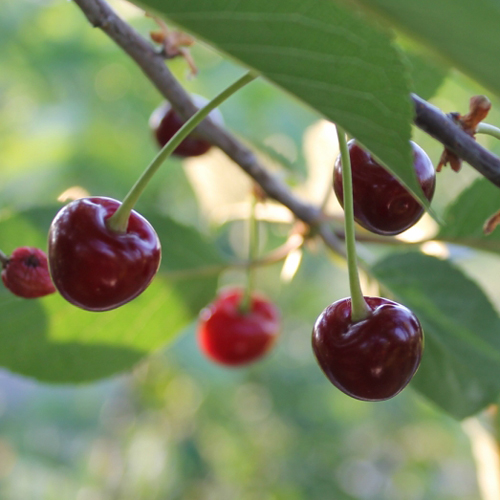
Description
The trees are not tall, of medium vigor, up to 2.8 - 3.5 meters high. Crohn's most often acquires wide-pyramidal outlines. In the habit, there are traits common with the parents - straight and smooth shoots, covered with dark brown bark, and dense large buds - this is typical of sweet cherries. And the crown of the duke looks more like a cherry, as well as the leaves, although they are somewhat larger. The base of the leaf plate is rounded, the apex is blunt-pointed, the edge is serrate-crenate. The surface of the leaf is slightly glossy, dark green, the underside is lighter, prominent veins are clearly visible on it. Inflorescences are collected in clusters, consisting of 6 - 8 flowers. The flowers of the variety are shaped like cherry flowers, but larger in size. If the weather is warm, Night blooms early - in mid-May. In cool regions, flowering is late and falls on the beginning of June, which, accordingly, shifts the ripening time. Abundant flowering.
Duke's fruits are large, weighing up to 7 grams, wide-heart shaped. The skin is glossy, dark red. The pulp is dense and juicy, burgundy-red, colored juice. The taste is excellent. The taste, in which the leading note is sweetness, is more reminiscent of cherry, but the smell is cherry, pronounced. Assessment of tasters - 4.7 points. The bone at Nochka is medium in size, half separates from the pulp.
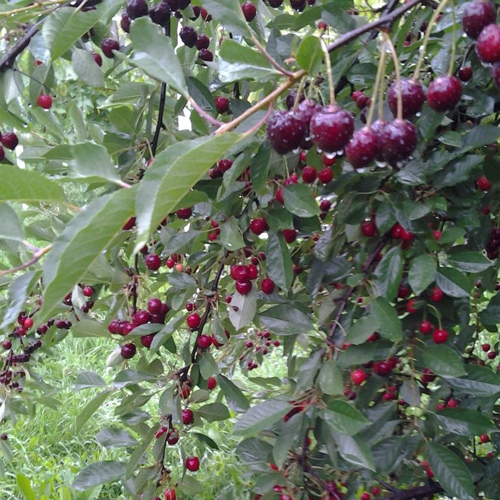
Characteristics
- The early maturity of the hybrid is good, 3 - 4 years after planting, the tree pleases with the first harvest;
- drupes ripen in late June - early July;
- the yield is low, according to various sources - from 10 to 12 kg per tree, but with good care, some sources promise up to 20 kg. The peak of fruiting occurs at the 12th year of the duke's life;
- Nochka's frost resistance is very good, the tree can easily withstand frosts at -35 ° C. This feature makes it possible to grow this variety even in the Non-Black Earth Region;
- the cherry's immunity is quite strong - it is resistant to moniliosis, anthracnose, clasterosporium. But in troubled years and in the absence of preventive treatment, it can suffer from coccomycosis;
- the variety is quite resistant to dry periods;
- if you remove the drupes together with the stalk, the berries will withstand transportation;
- fruits of this variety are most often used in natural form or as a dessert. But they can also be processed and made excellent jam, jam, compote. In addition, drupes are dried and frozen.
Pollinators
The night is partially self-fertile. In order for a duke to start a full crop, it needs suitable pollinators. But the information on them is very contradictory. Cherry varieties are most often recommended - Pink pearls, Napoleon pink, French black. From the columnar ones, Queen Mary will do. Other sources recommend only cherry as a pollinator - Nord Star, Youth, Meteor, Lyubskaya.
Planting and leaving
Depending on the region of cultivation, planting can be carried out in the spring, before the buds have blossomed, or in the fall, when at least 3 weeks are left before the onset of stable cold weather. It is advisable to prepare the planting hole in advance, filling it with well-rotted humus and phosphorus-potassium fertilizers.In cool regions, the first 3 years after planting, the seedling needs to be insulated for the winter - wrap the trunk with any breathable material and close the trunk circle with a 15 - 20 cm layer of mulch.
Duke care is no different. The main thing is to water on time, feed the cherries and loosen the soil in the near-trunk circle, at the same time freeing it from weeds. But pruning is somewhat different from the standard, since it must be carried out according to the principle of pruning cherries.
The night has excellent taste, it is frost-resistant and disease-resistant. Taking care of the plant is pretty easy. These advantages easily overlap the not very high yield of the variety.

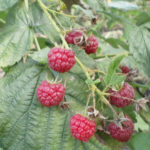
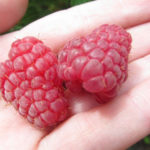

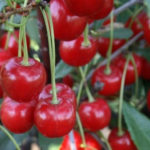
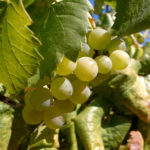



My night has been growing on the site for five years now, it pleases me with its harvest and excellent taste. But in the early years I almost killed her, so I want to warn inexperienced gardeners - do not overfill the tree, especially after flowering and before harvesting. I poured it, thought that I was doing well, but as a result, resin began to appear on the branches and the berries, almost all rot. As a result of correct pruning and subsequent correct watering, my Nochka recovered. And one more thing - cut to the maximum, do not regret, then there will be large berries, albeit in smaller quantities. Today it is one of the best varieties.